 |
 |
 |
|||||||||||||||||||||||
Luxor Museum of Ancient Egyptian Art Luxor Museum of Ancient Egyptian Art is a two-story building in a picturesque area of the city, on the eastern bank of the Nile. Its construction was conceived by the Ministry of Culture of Egypt in the second half of the XX century. In 1962, the Egyptian architect Mahmoud El Hakim created a plan for the museum building. In 1975, after the construction was completed, the museum was open for its visitors.
In 2018, the Luxor Museum was visited by the ISIDA Project research team for studying the history of excavations in Luxor and its environs. As the result, we invite our readers to take a virtual photo-journey into the Luxor Museum and into the Ancient Egypt as well.
General view of the halls of Luxor Museum
* In 1903, the French archaeologist Georges Albert Legrain made an important discovery during the archaeological works in the Karnak Temple. In the north-western part of the Temple of Amun, before its VII Pylon, he discovered an ancient cachette, containing about 800 stone and 17,000 bronze statues, as well as a great number of other egyptian artifacts. Most of them were moved to the Egyptian Museum in Cairo. (Further in report, the artifacts found in this place will be accompanied by the mark "Karnak Temple Cachette").
XIX Dynasty, Reign of Ramses II, New Kingdom, 1279 BC. Limestone. Ameneminet's official career began when he was appointed a Royal Charioteer and the king's Superintendent of Horse. He went on to become Royal Envoy to All Foreign Lands, a very high rank at the court; in this capacity he reported to the king directly on all issues affecting Egypt's relations with her neighbours, a department of state on which Ramesses placed great importance. Later still, he was Chief of Works and Commander of the Medjay Militia.
 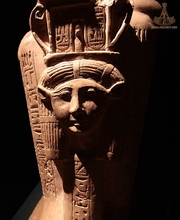 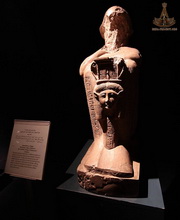 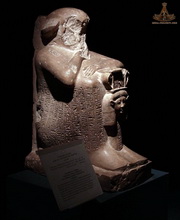 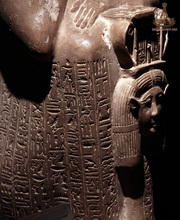 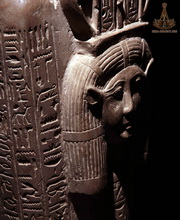  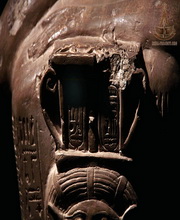
Head of the statue of King Amenhotep I. XVIII Dynasty, New Kingdom, 1525-1505 BC. Karnak Temple Cachette. Sandstone. After his death he shared a mortuary temple, and possibly a tomb, with his mother, though the tomb's location is unknown.
Amenhotep II Bust of King Amenhotep II. XVIII Dynasty, New Kingdom, 1427-1400 BC. Granite.
Amenhotep III Statue of King Amenhotep III, New Kingdom, XVIII Dynasty, 1405-1367 BC. Quartzite. Amenhotep III was buried in the Valley of the Kings, tomb KV 22.
Head of the statue-colossus of Amenhotep III, wearing the Red Crown of Lower Egypt. New Kingdom. 1403-1365 BC. Height - 1.24 m, width - 0.94 m, depth - 1.1 m. Quartzite. Head of the colossal statue of Amenhotep III. New Kingdom, 1403 - 1365 BC. Red granit. Amenhotep IV (Akhenaton) Amenhotep IV ruled about 1353 to 1336 BC. Until the fifth year of his reign, he was known under the name Amenhotep IV, which in translation from the ancient Egyptian means "Amon is pleased." Having throwing a challenge to the established religious tradition, the King has defined a new religion, that believed that there is only one God - the Sun God Aten. In this regard, he changed his name to Akhenaten, which means "Useful for Aten". Head of the statue of Akhenaten, New Kingdom, XVIII Dynasty. Sandstone.
Bust of Akhenaten, New Kingdom, XVIII Dynasty, 1352-1336 BC. Sandstone. Mut and Amun The statue has inscription representing the titles of the King User-Maat-Ra, Setepen-Ra beloved of Mut, Lady of Heaven - Ramesses II (User-Maat-Ra Setepen-Ra). The statue of God Amun and his wife, the Goddess Mut, sitting on the throne of the King Seti I. Cobra Headless statue of Amun-Re Kamutef, from Luxor Temple Cachette. XXV Dynasty, 689-664 B.C., Reign of Taharqa. Height of cobra 1,59 m. Grey granite.
Horemheb - an Ancient Egyptian military leader, who later became the last King of the XVIII Dynasty. He reigned about 1319-1292 BC. He destroyed the cult of Aten, established by Akhenaten. Having no heirs, Horemheb handed over his Throne to his associate - Ramesses I. King Horemheb kneeling before Atum. Carved in Diorite, Atum is 1,71 m high and Horemheb is 0,83 m. XVIII Dynasty, 1338 - 1308 B.C. The statues of Horemheb and Atum fit into recesses in the base (maybe to make moving the tableau easier. Horemheb is holding two spherical vessels and is wearing the Nemes headdress, uraeus, royal beard, shendyt-kilt and sandals. The inscriptions say King Lord of the two lands (Djeser-Khepru-Re Setep-en-Re Heka-Maat). Atum is sitting on a throne wearing the double crown, long wig and a curved beard. His right hand is holding an Ankh. Each side of the throne is decorated with two Nile God which represent the unification of upper and lower Egypt, the lily on the right and the papyrus on the left.
Amun's hand is resting on Horemheb's crown. Horemheb is wearing the Nemes headdress, Uraeus on his forehead and is holding a crook against his chest - the left hand is holding a scroll. Amun is wearing the characteristic crown with two tall feathers. The throne has a papyrus thicket surrounded by a patterned freeze. The back of the pillar is inscribed with a column of hieroglyphs flanked by two palm-leaves. The text reads "live the perfect god, images of Re, king of upper and lower Egypt, lord of the two lands, lord of action, Djeser-Khepru-Re Setep-en-Re, son of Re, of his body his beloved Horemheb-Mery-Amun given life like Re eternally". Another diorite statue of Horemheb (partly broken). XVIII Dynasty. Diorite. Horus The statue of God Horus. XXV Dynasty, 751-656 BC. The Third Intermediate Period. Calcite (alabaster).
Iwnit Temple of Amenhotep III, Luxor Cachette *.
Statue of the goddess Iwnit. XXVIII Dynasty, 1405-1367 BC, Reign of Amenhotep III. Diorite. Nakhtmin Head of the Army General Nakhtmin. XVIII Dynasty, New Kingdom, 1336-1327 BC. Calcite (alabaster) Nakhtmin who lived during the reign of King Ay, successor of Tutankhamun, was holding important titles such as the Prince, Royal Scribe, and General. Nakhtmin was a serving officer in the Army who was also a significant figure at the court during the reign of Tutankhamun. This head is a part of a fragmentary monolithic pair statue of husband and wife,represents Nakhtmin, a royal scribe and army general under Tutankhamun and his successor, Ay. Along the right-hand side of his wig can be seen the remains of the ostrich-plume fan, that served as a symbol of his rank. Nakhtmin was heir apparent, and possibly the son of Ay, but was supplanted bt Horemheb, who may have had this statue destroyed. Nebra The statue of the Military Commander Nebra, holding a standard. XIX Dynasty. Sandstone. This statue was found at the fortress of Zawiet um el-Rakhem, built to protect the western border of Egypt from the Libyans. Nebre was the commander of this fortress under Ramses II. In one hand, he holds his staff of office, topped by the head of Sekhmet, lioness-headed goddess of war. Nespeka-Shuty This exquisite block statue representing Nespeka-Shuty, a Vizier, a Judge and Priest of Amun and Maat, is decorated on three sides with worshipping scenes.
Statue of Ramesses III, XIX Dynasty, New Kingdom, 1185-1153 BC, Karnac. The statue was discovered during excavations in the Temple of Mut, Eastern Thebes. Greywacke. In this beautiful sculpture, which was most likely a cult statue, Ramses III, last great warrior king of the New Kingdom, wears a short wig surmounted by the double crown and a pleated garment fronted by large trapexoidal panel. In front of him was once a figure of the mummiform god Osiris, only traces of which remain against his torso. A prince, Pareherwenemef, who was commander of the army and the king's fan-bearer, is depicted on one side of the statue, behind the left leg of his father. One part of his sculpture was discovered in the 1930s by the Priental Ibstitute of Chicago; the rest was discovered in 2002 by an expedition from John Hopkins University. The pieces were under the floor of Temple C in the Nut Precient at Karnak, and it is hoped that more fragments will be found as excavations continue. The pieces were reassambled and restoted in 2003. Ramesses VI Standing statue of King Ramesses VI, presenting a statuette of Amun-Re. XX Dynasty, New Kingdom, 1150-1145 B.C. Karnak. Green schist. The reign of Ramesses VI was uneasy. Already in the first year of his reign, Egypt experiences threats of a new Libyan war that caused various internal riots. During the reign of Ramesses VI, Egypt has completely lost its foreign possessions, except for Nubia. When he died he was buried in KV 9 but was later moved with Ramesses V to KV 35.
Statue of Remesses VI. XX Dynasty, Karnak Cachette, grey granite. This statue, which once stood in the temple of Amun at Karnak, shows Ramesses VI standing, grasping the hair of a Libyan prosoner (identified by his sideblock) in his left hand and an axe in his right. Between the legs of the prisoner is a lion, symbol of royal power. Ramesses is also protected by now headless figure of Horus as a falcon, which can be seen behind his crown. Statue of a Prisoner. New Kingdom. Qasr el-Koba (Cairo). Grey granite. A prostrate enemy is shown here, his hands tied uncomfortably behind his back in the typical posture of the subjugated prisoner. His features and hairstyle identify him as a native Syria-Palestie. The inscription bears an offering prayer, dedicated to a man named Peninhery. Amenhotep, son of Hapu Statue of Amenhotep, son of Hapu. XVIII Dynasty, New Kingdom, 1430-1350 BC. Grey granite.
Mentuhotep III Middle Kingdom, 11th Dynasty, 2010 - 1998 B.C. Monthu Temple, Armant. Sandstone. Statue showing the King Mentuhotep III as Osiris with a tall crown, long beard and an full-length cloak.
Headless statue of Mentuhotep in the form of a scribe. XII Dynasty, Middle Kingdom, ~ 1800-1700 BC. Gray granite.
Steated statue of a Scribe Steated statue of a Scribe The cartouche on the shoulder of the statue bears the title of King Amenhotep II.
God Sebek and King Amenhotep III The statue was found in the the Sobek temple at Dahamsha during 1967 by workers digging of the Armant Canal in a shaft closed by the sandstone slab - the slab slid into place on two bronze wheels. Sobek is seated in a human form with the crocodile head and his right hand holds the Ankh giving life to the youthful Amenhotep III. The King is wearing the Nemes headdress, with the uraeus and royal beard. The statue was later usurped by Ramesses II. The back is carved with 5 vertical hieroglyphics lines showing the King Ramesses's name and titles. Goddess Sekhmet Sekhmet, in Egyptian mythology, is the Goddess of War and at the same time the Goddess of Healing. She is depicted as a woman with the head of a lioness, the most dangerous predator known to the Egyptians. Sekhmet protected the Pharaohs, leading them to the war. She is called "the terrible eye of Ra". Hot winds and sunrays were considered as the breath of Sekhmet. There is an ancient Egyptian belief that in the ancient times her breath formed the desert. In the explanation of ancient mythology by means of the natural elements, Sekhmet is identified with a "Sun Burst".
Senwosret I (Sesostris I) The statue of Sesostris I in the form of Osiris from the Temple of Amon in Karnak. XII Dynasty, Middle Kingdom, 1971-1926 BC. Limestone. Senwosret was one of Egypt's greatest kings. The speed and decisiveness which marked his accession were repeated in the frequent and far-ranging military campaigns which he undertook. He was a great builder and was responsible for one of the most beautiful of all Egypt's buildings, the so-called White Chapel at Karnak, a small chapel which served as a 'way-station' for the god and his priests as they processed round the temple. He also built what may have been the first 'new town' in history, Itj-tawy. His immense pyramid complex at El-Lisht was surrounded by the tombs, many of them of considerable splendour, of his great offic-ers of state. For centuries after his death Senwosret was worshipped as a god. His reputation grew and was conflated with that of his descendant, Senwosret III to produce the composite mythical king Sesostris, whose legend has persisted to the present day.
Seti I Statue of Seti I. XIX Dynasty, New Kingdom, 1294-1279 BC. Calcite (alabaster). Seti I succeeded after his father's brief reign which inaugurated the Nineteenth Dynasty. Prior to Ramesses' accession Seti had been a highranking officer in the Army; under his father, and also possibly during the latter part of the reign of King Horemheb. He was especially concerned with Egypt's foreign relations. It was Seti, more than any other, who restored Egypt's status in the world, after the uncertainties of the Amarna period and its immediate aftermath. In the early years of his reign he led a number of campaigns into the lands beyond Egypt's frontiers. He was particularly active against the Hittites, a power which was to play an important part in the foreign relations of his son, Ramesses II. In Egypt itself Seti continued Horemheb's policy of repairing the ravages of the Amarnan period. Seti and his successors maintained the position of Thebes as the religious and secular capital of the country. Seti's funerary temple at Abydos is one of the supreme masterpieces of New Kingdom architecture. The exceptional richness of the wall reliefs and the brilliance of colour in the interior make the temple an outstanding example of the Egyptian creative genius. Seti commissioned a list of his predecessors (the 'Abydos King-List') to be displayed in his temple at Abydos. His tomb (KV 17) is also one of the largest and most magnificent in the Valley of the Kings with, amongst other notable features, a superb astronomical ceiling. Thai Statue of Thai the Scribe. The reign of Amenhotep III, New Kingdom, 1388-1353 BC. Ebony.
Bearer of the Gold of Honour Officer decorated with the Necklace of honour, Dynasty XVIII, New Kingdom,1440-1400 BC. Found Qau el-Kebir. Sandstone. Thutmose III Statue of Thutmose III. XVIII Dynasty, New Kingdom, 1479-1425 BC. Karnak, Cachette. Height - 0.90 m. Graywacke. Statue of Thutmose III. XVIII Dynasty. Deir el-Bahari, Temple of Thuthmose III. Granodiorite. This beautiful statue represents the great warrior king Thuthmose III, seated on a throne. The inscription gives his titulary and calls him beloved of Amun, god of Thebes and the most important state god of the New Kingdom. The statue was found in 1965 in the King's now destroyed Temple at Deir el-Bahari and left in a magazine on the West Bank. In 2003 it was given to a young Egyptian restorer, who has restored it to its original glory. It is displayed here for the first time. Broken statue of Thutmose III. XVII Dynasty, 1490-1436 BC. Official with elaborate wig Limestone. 1290-1210 B.C. Thebes. The bland expression and breadth of face and curled wig are typical of sculptures, produces under the Rammeside Kings.
Block statue of Yamunedjeh the Scribe. XVIII Dynasty, New Kingdom, 1479 - 1425 BC. Reign of Thutmose III, Found during the excavations in Qurna. Gray granite. Yamunedjeh was a royal herald and architect under Thutmose III, and was greatly honored by that king. This statue was found near the mortuary temple of the King and was most likely set up within the sacred precinct so that Yamenedjeh could share in the offering cult. The inscription on this statue states that this man accompanied his monarch into Syria in Year 33, crossing the Euphrates "behind his Majesty in order to secure the boundaries of Egypt." Tuya Canopic jar lid of Queen Mut-Tuya, wife of Sety I and mother of Ramesses II. Made of Calcite. from the Valley of the Queens. XIX Dynasty.
Ancestor Bust of Pa-en-djerty This sculpture came to light during the clearing of a Theban tomb belonging to Amenmose, who was the Royal Scribe of the Altar of the Two Lands. The name of the tomb owner does not appear on this bust, which depicts his father, Pa-en-djerty.
Sphinxes From the left: Sphinx making an offering. Original sculpture had human arms and a vase. Could be Tutankhamun. From Karnak. XVIII Dynasty, about 1350 BC. Calcite. From the right: Phinx of King Tutankhamun, XVIII Dynasty, 1347-1339 B.C. Alabaster. Sphinx. Limestone. Mummies Mummy of Ahmose I, founder of the XVIII Dynasty, New Kingdom, 1550 - 1525 BC. . Ahmose I was the founder of the XVIII Dynasty and, consequently, the establisher of the family, which ruled the Egypt for more than two centuries. The Mummy of Ramesses I. XIX Dynasty, New Kingdom, 1292 - 1290 BC.. In 1999, the entire collection of the museum was purchased by a private collector William Jamieson from Toronto. In the same year, Jamieson sold his Egyptian collection, including an unidentified mummy, to the Michael C. Carlos Museum (MCCM) in Atlanta, Georgia (USA). And only there, together with the specialists from the Emory University School of Medicine, the mummy was identified as the mummy of King Ramesses I, the Founder of the XIX Dynasty of Egypt. In 2003, the Museum of Atlanta gratuitously returned the mummy of Ramses I to Egypt as a gift of goodwill and international cultural cooperation. Sarcophagus Coffins of Imeni and Geheset The box-shaped (exterior) wooden coffin inscribed for Imeni. The unusual feature of this coffin is the remarkably well-preserved decoration of all inner walls,which are adorned with the 'Coffin Texts' and polychrome representations of the ideal burial equipment. The second wooden coffin which was inside Imeni's coffin is decorated with bands of insciption only on the exterior. These inscriptions name not, as expected, the name and title of Imeni, but those of 'his beloved wife the lady Geheset'. This well-preseved coffins were discovered in 2004 at the Dra Abu el-Naga necropolis in western Thebes by the German Archaeological Institute Cairo and is on display at the Luxor Museum since 2007.
Octagonal Pillar of Antef II XI Dynasty, Middle Kingdom, First Intermediate Period. Llimestone. Wahankh Antef II (also Inyotef II and Intef II) was the third ruler of the XX Dynasty of Egypt during the First Intermediate Period. He reigned for almost fifty years from 2112 BC to 2063 BC. His capital was located at Thebes. In his time, Egypt was split between several local dynasties.
(At that time, Egypt was territorially divided among several local dynasties (nomes), each having its own capital city.)
XVII Dynasty, Karnak. Limestone. This is one of pair of stelae set up by Kamose of the XVII Dynasty in the 3rd year of his short reign. The inscription here, which begins on the fragmentary first stela of the pair, tells of his victories over Hyksos, whom he pushed back into their Delta capital of Avaris. (He did not, however, defeat them utterly; this was left for his probable brother, Ahmose, to do t wenty years later).
Thutmose III Limestone block from a temple wall at Deir El Bahari (western Thebes). Thutmose III (Men-Kheper-Ra, ruled c.1479-1425 BC) wearing the Atef crown.
God Amun - Min Relief of God Amun - Min. New Kingdom, 1490-1436 BC. Deir el-Bahari. Limestone. This relief shows the god Amun merged with fertiliy god Min. The relief was destroyed during the Amarna period and restored by a later king.
Fragment of the ainted block of Thutmose III, New Kingdom 1498-1456. Limestone. Painted block of Thutmosis III Painted block with bas-relief from Deir el-Bahari Stela of Amenhotep II Stela with a bas-relief of Amenhotep II. XVIII Dynasty, Karnak. Red granite. Amenhotep II was well known for his athletic abilities as a young man. One of his greatest athletic achievements was accomplished when he shot arrows through a copper plate while driving a chariot with the reins tied about his waist.
Akhenaten, early in his reign, constructed a number of temples at Karnak. These employed the characteristic art of his period and were also constructed with small blocks, known as "talatat". After the Amarna Period the temples were dismantled, and together with other useful building material were re-used in construction of other objects. In particular, a large number of "talatates" were used in the construction of the IX Pylon of the Temple of Amun in Karnak during the reign of Horemheb. During the archaeological work in Karnak, thousands of fragments of these "talatat blocks" were discovered. Part of them (183 pieces) were assembled on one of the walls of the Luxor Museum in a mosaic of 18 meters length. The scenes, depicted in it demonstrate the everyday life of ordinary people.
Funerary stela of Nehemesbastet XX Dynasty. 850 BC, King's Valley, KV 64. The seceased lady worships the underworld deity Ra-Harakhte-Atum-Osiris. Stela of Amarna Period
Jewelry Flies of Valour of Ahhotep It was found in 1859 and since then it has been kept in the Luxor Museum. The military leader Ahmose Pen-Nehebt (relative of Ahmose), wore six gold flies and three gold lions. Another Ahmose, the son of Abana, had three golden flies. Under the reign of King Thutmose III, "Golden Fly" became the Order - the highest military award of Egypt. It was available to all the military ranks, including ordinary soldiers.
Other jewelry, made of gold, bone and stone. Other different artifacts
Sundial perhaps used to measure the duration of work shifts for workmen. Found in workmen's hut in front of King's Valley tomb KV 29.
XX Dynasty, 1150 BC. Perhaps part of a shawl or piece of clothing. King's Valley tomb KV 31.
XVIII Dynasty. 1370 BC.
Glass flask XVIII Dynasty, 1370 BC, King's Valley tomb, KV 64. Glass flask for perfume or cosmetic oil.
XVIII Dynasty, 1370 BC. King's Valley, tomb KV 40. Two canopic heads Limestone.
XVIII Dynasty, New Kingdom, 1473-1458 BC. Porphyry. Senenmut, despite his non-royal origin, was the Royal Steward, Architect and Royal Representative during the reign of Queen Hatshepsut. As an architect, he supervised the building of the Hatshepsut obelisks in the Amon-Ra temple in Karnak and in particular has created the magnificent Mortuary Temple for the Queen in Deir el-Bahri, skillfully installing it into the steep rocky landscape of the Western Thebes. Senenmut was awarded the unique right to build his own tomb near the Temple of Hatshepsut. This tomb is famous for its astronomical ceiling, depicted by Senenmut, which indicates the multifaceted interests and high education of the great Egyptian Architect. Tools From the left: fragment of a schist cubit rod (measuring stick), bearing the cartouche of Nectanebo II. Karnak. From the right: wooden A-frame with a stone plumb bob, used to level horizon and wooden vertical level with stone weight, from the tomb of zonal surfaces. The artifacts were found, during excavations in Kurna and Lahun. Miniature figurines, vases, ushabti, fragments of art Wooden models of vessels and figures of sailors Dagger and sheath of Ahmose XVIII Dynasty, found in Dra abu-Naga. Ceremonial axe of Ahmose XVIII Dynasty. Gold, electrum, copper, semi-precious stones and wood. Found in the burial of Queen Ahotep. This axe celebrates the victory of Ahmose. It bears the king's titulary, along with images of the king smiting an Asiatic ebemy and prayers for many years of rule. Weapons of the New Kingdom
Sketches of plans Plans of various structures, made on the fragments of white limestone.
Plan, on limestone, of what is probably the tomb of Ramesses IX, from the Valley of the Kings at Thebes. Plan of the building on a limestone flake from the Valley of the Kings at Thebes. New Kingdom. Ostracon. New Kingdom. Master's board New Kingdom. Dra abu-Naga (TT 11-12). Wood coated with stucco. Discovered in 2004 during excavations by the Spanish mission to Dra abu-Naga, this master's board bears the plans for several pieces of royal art. On one side, atop a carefully planned grid, are the figures of two statues. On the other side, inverted as if the artist had flipped the board over, is the figure of a King in the red crown of Lower Egypt fowling in the marshes. Perhaps the plan for wall relief.
Coptic Stele Early Christian Stela of a stylized fish, c.6th to 7th century AD, in Limestone from Luxor.
Early Christian Stela Since roman times the Christians of Egypt were called Copts. Their grave-stones often carried crosses and other Christian symbols. Sandstone. VI -VII A.D. Thebes. Coptic grave-stone The decoration consists of architectural elements and crosses. Sandstone VI-VII A.D. Thebes. The plaque has a Greek prayer by Taimon to Jesus Christ.
REFERENCE:
|
|||||||||||||||||||||||||
 |
 |
 |